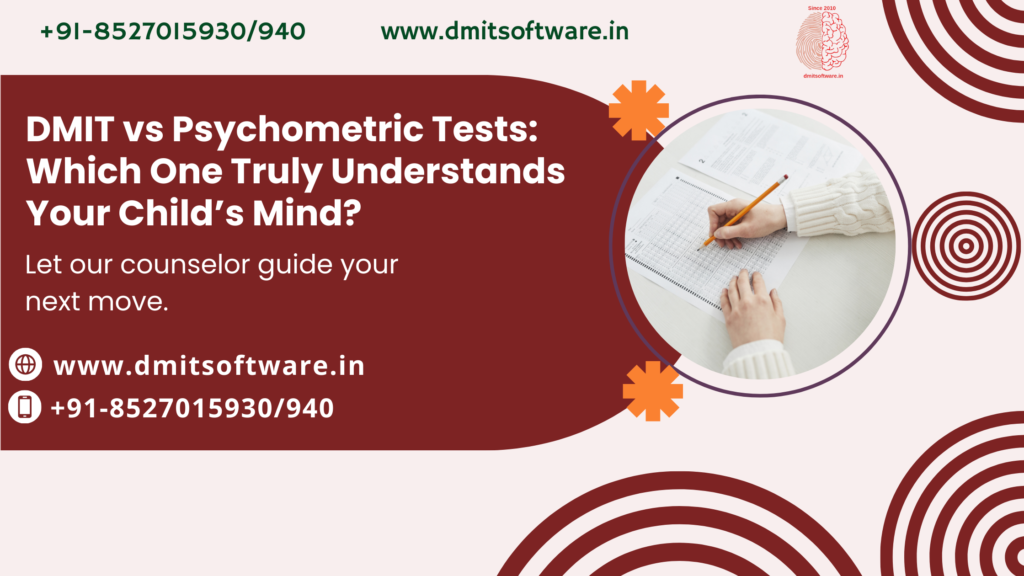DMIT vs Psychometric Tests: Which One Truly Understands Your Child’s Mind?

As parents and educators, the desire to understand a child’s mind is universal. Understanding what motivates them, where their talents lie, or how they process information can unlock their potential and guide them toward a fulfilling future. Two methods gaining attention for understanding children’s abilities and unique traits are the DMIT test and psychometric tests. But which one is right for your child?
This blog will explain what DMIT and psychometric tests are, how they work, and their strengths and limitations. We’ll also compare the two methods, share real-world applications, and offer insights to help you choose the best approach for your child.
DMIT Explained
What is DMIT?
DMIT, or Dermatoglyphics Multiple Intelligence Test, is a scientific method that analyzes fingerprints to reveal unique insights about a person’s brain and potential. It stems from the study of dermatoglyphics, which focuses on the patterns of ridges on fingers and palms. Proponents of DMIT believe that these patterns are linked to our brain’s development and can provide a window into our innate talents, learning style, and multiple intelligences as defined by educational theorist Howard Gardner.
How Does DMIT Work?
- Fingerprint Analysis: Each fingerprint is scanned to assess unique ridge patterns.
- Brain Mapping: The data is analyzed to correlate fingerprint patterns with corresponding areas of the brain.
- Results: The test provides insights into learning styles, strengths, weaknesses, and potential career paths.
What Does DMIT Aim to Reveal?
DMIT claims to uncover the following:
- Learning styles (visual, auditory, kinesthetic).
- Interpersonal and intrapersonal intelligence.
- Cognitive processing speeds.
- Areas of natural aptitude and potential career directions.
It is often marketed as beneficial for children to better understand their abilities early in life.
Psychometric Tests Explained
What are Psychometric Tests?
Psychometric tests are standardized assessments designed to measure cognitive abilities, personality traits, and emotional intelligence. These tests aim to objectively quantify a child’s aptitude, preferences, and psychological profile, providing actionable insights for their development and support.
How Do Psychometric Tests Work?
- Assessment Categories: Tests typically focus on areas like logical reasoning, spatial ability, verbal proficiency, and emotional traits.
- Questions/Exercises: Children answer a series of questions, puzzles, or problem-solving tasks.
- Analysis and Reports: Scores are calculated to deliver a detailed overview of a child’s abilities or traits. These results are compared against standardized benchmarks.
What Do Psychometric Tests Reveal?
Psychometric tests for kids measure:
- Cognitive capabilities like reasoning and memory.
- Personality traits such as openness and extroversion.
- Emotional intelligence and stress management.
These tests are widely used in educational institutions, career counseling centers, and by psychologists.
DMIT vs Psychometric Tests: A Detailed Comparison
Key Differences at a Glance
| Criteria | DMIT Test | Psychometric Test |
|---|---|---|
| Scientific Validity | Based on dermatoglyphics; limited scientific validation as a behavioral predictor. | Backed by decades of research in psychology and neuroscience; scientifically validated. |
| Methodology | Fingerprint scanning and pattern analysis. | Standardized questions and tasks measuring cognition, personality, and traits. |
| Areas of Focus | Focuses on multiple intelligences, learning methods, and innate abilities. | Measures cognitive abilities, personality traits, and analytical skills. |
| Result Type | Qualitative “brain profile” linked to innate potential and intelligence types. | Quantitative scores comparable with standardized norms. |
| Applications | Typically used for identifying learning styles and career guidance for children. | Used for academic performance, emotional well-being, recruitment, and personal growth. |
| Customization | Results are generalized; not based on time-sensitive inputs. | Results are dynamic and reflect the child’s current mental state and learning capacity. |
| Suitability for Age | Recommended for children aged 3 and above. | Suitable for children, adolescents, and adults. |
DMIT Strengths
- Highlights innate strengths and multiple intelligences.
- Identifies learning preferences and optimizes education plans.
- Easy to administer, making it child-friendly.
Psychometric Strengths
- Scientific credibility and standardized methods.
- Tracks not just potential but current skillsets and traits.
- Applicable across various stages of life, not limited to children.
Potential Drawbacks of DMIT
- Limited scientific validation for linking fingerprints with brain mapping.
- Perceived as more interpretive than precise.
Potential Drawbacks of Psychometric Tests
- Can be time-consuming and require professional administration.
- Performance may be influenced by the child’s mood, attention, or environment during the test.
Real-world Applications and Case Studies
DMIT in Practice
- Maximizing Learning Efficiency
A 7-year-old with a high auditory learning style struggled with traditional visual-based lessons. After DMIT testing, educators introduced audio books and auditory-lead instructions, resulting in a significant improvement in comprehension and academic performance.
- Career Guidance
An 11-year-old’s DMIT results revealed strong logical reasoning and interpersonal intelligence. These insights guided parents to encourage STEM-based activities alongside debate sessions, paving the way for a well-rounded development path.
Psychometric Tests in Practice
- Academic Support
A 10-year-old diagnosed with a specific learning disability underwent a psychometric evaluation identifying specific cognitive challenges. This allowed educators to tailor lesson plans in ways that complemented their learning style.
- Child Psychology Evaluation
A teenager displayed symptoms of heightened anxiety and mood swings. A psychometric test concerning emotional intelligence revealed sensitivity to peer pressure, enabling their psychologist to suggest coping strategies.
Both methods have demonstrated practical value but serve distinct purposes.
Which One is Right for Your Child?
The choice between DMIT and psychometric tests depends on your goals. If you’re looking for an overview of a child’s inherent capabilities and learning styles, DMIT may offer valuable insights. However, for precise, scientifically validated analysis of cognitive and personality traits, psychometric tests are more appropriate.
It’s worth consulting with a professional coach, educator, or psychologist to determine which method aligns with your child’s unique needs and challenges.
Actionable Takeaways for Parents and Educators
- Start with your goal. Are you seeking to better understand learning preferences (DMIT) or gain a data-driven cognitive profile (psychometric test)?
- Speak with experts before deciding on an evaluation technique.
- Remember, no test is perfect. Use insights as part of a broader development plan.
Your child’s future deserves thoughtful decisions supported by the right tools.
